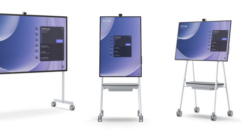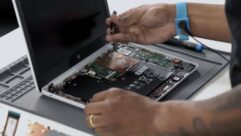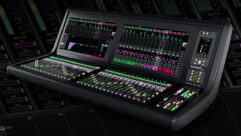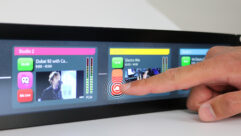The Surface
Aug 1, 1999 12:00 PM,
June Lee and Jim Scrivner
Most homeowners live with increasingly obsolete traditional wiring – theelectrical wiring and telephone wiring standard in houses. Older houses useCAT 3 telephone wiring, but most new houses have CAT 5 telephone wiring,which is capable of faster data transmission rates. When homeowners need anadditional line for a fax machine, the phone company gets called in. Whenhomeowners need to create a small LAN (local area network) so two computerscan share files easily, they make a run to the local computer store for anetworking kit, which includes network cards, a hub and cables. Add thecards to the computers; hook the two computers together through the hub andcables, and the network is complete.
What if the computers are in separate rooms, half a house apart, and theyneed to share a cable modem located in a third room? When a securitysystem, a home theater or computers in multiple rooms are added, the funtruly starts. The cables seem to sprout at random, entangling themselveswith the furniture and equipment. The homeowners eventually realize thatthere must be a better way to do all this wiring, and it is at this pointwhere residential structured wiring usually makes its entrance.
Over the past several years, cable technology and standards have made hugestrides in the business sector, and homeowners are beginning to demandsimilar technological advances at home to support their electronic needs.When homeowners want modern home theaters, telecommunications, computingnetworks, security and home automation, they look to contractors forresidential structured wiring solutions, either for homes being built orrenovations.
Structured telephone wiring has been the norm; phones are connected to walloutlets via telephone wires – simple and clean connections, but times havechanged. With the home becoming increasingly dependent on othercommunication modes – data transmissions via the Internet or audio signalsbetween a DVD player and a whole-house stereo audio system – homeownerswant a wired house, well-planned and ready for any and all devices, andthey want discreet cabling within the walls – no more bunches of cables outin the open.
Cable
Before diving into residential structured wiring systems, it is importantto understand the cables that make up these wiring systems. Cable is theweakest link in any chain of electronic devices. You may not notice thedifference a poor quality cable makes to a standard video signal, but youwill notice it when watching an HDTV signal. An entire system can beadversely affected by poorly performing cable. To minimize signal loss forthe best possible price, it is important to understand the cables availableand their associated specifications.
So many different types and models of cables exist that one could easilybecome intimidated by simply paging through a cable catalog, but cables arereally not that different. They are essentially various combinations ofbasic configurations. These cable types have great differences in size,capability, quality and performance within their own groups, but mostcables fall into four main groups – individual conductor, twisted pair,coaxial and fiber optic. (Please see “Fiber Optics in the Home,” page 32,for more information on fiber-optic cable.)
Referred to as wire, individual conductor is the most basic of cables (seeFigure 1). It consists of a center conductor wrapped in a plastic orrubberized outer jacket. This cable type is generally used to distribute such low-frequency signals as digital communication signals and computer ID bitinformation. Larger variations of this cable type are used to distributepower.
Twisted-pair cable is available in two different styles. Shielded andun-shielded twisted-pair cables are found in environments ranging fromtelephone to computer networking to professional audio (see Figure 2 andFigure 3). Twisted-pair cable consists of two individual conductors,generally running signal and return (ground), that have been twistedtogether to form one pair of cables. Usually found with 100 V impedancevalues and in AWG#22 to AWG#24, twisted-pair cable is inexpensive and easyto handle. Because both conductors have equal exposure to extraneous noise,twisted pair cabling, by design, provides inexpensive protection fromoutside interference, RFI and EMI.
Most commonly seen in telecommunications and computer networkingenvironments, unshielded twisted pair is categorized to be compatible withthe many different data transfer rates associated with these types ofequipment. Shielded twisted-pair cable consists of a regular twisted pairthat is surrounded by a wire braid shield. This shield provides additionalprotection against EMI, making it useful for signal distribution ofsensitive audio and computer sync information.
More complex, coaxial cable consists of two conductors (see Figure 4). Thecenter conductor carries the signal while the outer conductor (shield)provides a return path for the current to ground and protects againstoutside interference. The two conductors are separated by a dielectricmaterial (insulation) that establishes electrical characteristics andprovides physical protection to the center conductor. All of thesecomponents are jacketed to make one cable.
In the A-V industry, these coaxial cables generally have 75 V impedance andare used in video applications and for applications involving testequipment, RF distribution and audio equipment. Because of the complexdesign, coaxial cable is more expensive, but it provides enhancedreliability. The frequency and resolution of a signal and the distance ofthe cable are important determining factors in deciding which grade ofcoaxial cable should be used because some provide lower signal losscharacteristics than others. The crimp style of cable termination(connectorization) used with these cables makes them easy to terminate infield applications, and they offer consistent, reliable connections.
Cable anatomy
Many people view cable simply as what is used to connect two pieces ofequipment. Not much attention is given to what is inside, even though thecomponents and the materials used are absolutely critical in establishing agiven cable’s performance in an application. These components determine theelectrical and physical properties of the cable. For this section we willuse the example of a coaxial cable because it contains all of the followingcomponents – conductor, insulation, shields and jacket. In one form oranother, most cables use these various components in their construction.
The center conductor carries the signal from one point to another. Centerconductors are made of highly conductive materials that are capable ofcarrying electrical current. The most commonly used material is copperbecause of its overall conductive properties, availability, cost and easeof use. Other materials – aluminum, silver, gold – are available and usedin specific applications. Conductors have either a solid or stranded center.
A solid-center conductor is made of a single wire. The diameter or AWG sizemay vary, but solid-conductor cables are generally easier to manufactureand are therefore less expensive. These conductors are formable but not allthat flexible. A stranded center conductor consists of multiple small gaugewires that are twisted together to form a larger single conductor. Thesecables are flexible and easily handled. Generally speaking, however,performance will be slightly less in comparison to a solid conductor of thesame size and material.
Cable insulation, also called the dielectric, serves an important dualrole. It is the material that separates the center conductor from the outershield. This serves to protect the center conductor, but more importantly,it establishes electrical characteristics – impedance and capacitance -that greatly affect cable performance. Some of the more common insulationmaterials include polyethylene for general purpose cable and fluoropolymerfor plenum-rated cables.
Shields also serve an important dual role. A shield works as a secondconductor, which acts as a return path for the signal current to ground andalso protects the signal from outside interference. Because there aredifferent types of interference that cables may encounter (see Figure 5 andFigure 6), there are different shielding methods – foil, braid, andcombination foil/braid.
Foil shields protect signals from picking up high-frequency interference(RFI or radio frequency interference) from telephone, microwave, televisionstation and other transmissions. The foil shield is a foil-sided tape thatis wrapped completely around the cable’s insulation. A thin drain wireusually accompanies a foil shield, enabling connection to the shell of itsrespective connector. To form a braid shield that encompasses the cable’sinsulation, many fine strands of conductive material, usually tinnedcopper, are woven together. This method keeps out unwanted EMI(electromagnetic interference), a low-frequency, induced magnetic fieldcaused by such high-current machinery as air-conditioning units or electricmotors.
The outer jacket physically protects all the inner components from weather,chemicals, liquids, sunlight and other factors. Because of the diverselocations through which cables run, there are classifications to which acable must conform in order to be installed in specific environments. Thesestandards are governed by the NEC (National Electric Code) and have certainUL (Underwriters Laboratories) certifications.
Jacket material primarily determines a cable’s overall flexibility. Forexample, a plenum-rated cable will be stiffer and therefore more difficultto maneuver and terminate. Depending on the system’s certification needs,you would normally want to use the most flexible cable available.
Performance and specifications
Cable performance in a particular system is largely determined by thecable’s physical construction but is also influenced by length, frequency,interference, crosstalk, temperature and cable specifications.
As cable length increases, performance decreases. As the signal travelsthrough the cable, it is affected by the cable’s materials. The morematerial through which the signal travels, the weaker it becomes. Cableperformance is also affected by signal frequency. As the signal frequencyincreases, the detrimental effects that capacitance and conductor materialshave on the signal increase.
Outside interference can distort the signal if the cable is not properlyshielded. Interference can be caused by many factors, especially RFI andEMI. Crosstalk is a type of interference, but it is not induced from theoutside. It is created internally by signals being run together onadjacent, improperly shielded wires. When crosstalk occurs, datatransmitted through one line bleeds over and adds itself to the signal ofthe adjacent cable.
Because of heat-related conditions, all of the materials used in a cableare susceptible to performance variance. This can result in difficulttroubleshooting sessions. Cables are typically installed in such areas aswalls, ceilings and equipment racks. Because these areas are not alwaysproperly ventilated, they tend to be exposed to higher heat conditions.Therefore, it is important to select cables that will perform asconsistently as possible in these environments.
Cable specifications are the most important information that manufacturerssupply, so you should pay careful attention to these numbers before youchoose which cable to purchase. Many different specifications exist, themost critical of which are impedance, resistance, capacitance, andattenuation.
Impedance establishes the baseline for the flow of the signal. This flowmust be maintained throughout the entire system for proper transfer ofpower. If there are impedance mismatches, the possibility of reflectionsoccurring is high. The signal that is reintroduced to the original signalis called a reflection. Reflections are caused by impedance mismatch andimproperly terminated connectors.
Resistance is defined as “the property of a substance that impedes currentand results in the dissipation of power in the form of heat.” It is thecharacteristic that blocks the flow of electrons, hence affecting thevoltage (amplitude) of a signal. In cable, resistance is expressed asohms/1,000 ft (305 m). The resistance of a material is determined bymaterial type, dimensions and temperature.
Capacitance is defined as “the property of an electric system thatdetermines how much electrical charge will be stored in the dielectric fora given potential difference between the conductors.” In other words,capacitance is the ability of a component to charge, hold a charge anddischarge. The unit of measurement for capacitance is farad (F). In cable,capacitance is expressed as pF/ft (picofarads per foot). A coaxial cable isreally nothing more than a large capacitor.
Capacitance affects the rise and fall times of a signal. When a cablecharges, the electron flow first starts as a trickle and then graduallybuilds to the full pressure. When a cable discharges, the electron flowslows and then stops. For example, the supposedly black-to-white transitionof a video signal may actually be displayed as a black-to-gray-to-whitetransition instead.Attenuation is the most important performance specification, the cableequivalent to bandwidth. Measured in dB (decibels), attenuation, orinsertion loss, is a measurement of the amount of loss that will occur fromone point to another. For cable, it is referenced at a fixed length,normally 100 ft (30.5 m), and is rated at different frequencies. Forexample, -2.2dB/100 ft @ 100 MHz would be a typical way of indicating thespecification. At 200 MHz, the same 100 ft cable would have a differentattenuation value. With this specification, a system designer can get anexcellent idea of how much loss will be incurred in a system because thedesigner will know the signal rates and cable lengths used. Remember thatattenuation value changes as cable length changes.
Cable connectors
We begin to appreciate what important roles these cable components play inmaintaining the signal integrity of a system. If any component is damagedor not connected properly, many problems can occur, and system performancecould be significantly diminished. The type of connectors used will make adifference with such high-quality signals as HDTV signals. Compared to RCAconnectors, BNC connectors are sturdier and enable a more secureconnection. Additionally, most BNC connectors have 75 V impedance, which isappropriate for video use. Impedance mismatches in video systems can resultin signal reflections, which, in turn, can cause signal attenuation and forvideo signals, loss of picture detail and ghost images.
Signal enhancement
Various pieces of equipment offer features that enhance signals and/orenable the use of longer cable runs. We will describe two features and onedevice that specifically enhance video signals, but they do havecounterparts in such other fields as audio.
Level control increases the voltage of an entire signal so it can travellonger distances and withstand resistance in the system. Compensating forloss due to resistance, level is analogous to a brightness control -brightness increases as a function of voltage.
Peaking control sharpens the edges of a picture’s vertical lines.Compensating for signal loss due to capacitance, peaking increases asignal’s voltage only at the high frequency range.
A ground loop isolator eliminates hum bars and sync wiggles caused byimproper equipment grounding. A hum bar appears as a horizontal bar or linemoving vertically through the picture. Sync wiggles are represented ascontinuous movement or picture squiggling. Both are also referred to asground loops. A ground loop in the power or video signal occurs when thevarious system components are receiving power from different grounds, orthe ground potential between two pieces of equipment is not identical. Thedifferent AC potentials between the two grounds cause the loops to appear.One way to correct this problem is to have all the system components usepower from the same ground. In most cases, this is not an option. The othersolution is to use a ground loop isolator.
Emerging technologies
Various methods of communications are entering the home. You will encountermore and more home-owners asking you to add HDTV, Ethernet or othertechnologies to their homes. Below are several technologies with which youshould acquaint (or reacquaint) yourself. Research their pros and consthoroughly before you decide which residential structured wiring solutionsto implement.
– HDTV: Component video is a higher-quality video format than compositevideo. For standard TV signals, all the picture information is crammed intoone composite video signal and carried on one wire. For HDTV, in order tomaintain picture quality, you need to run component video lines for thethree HDTV signals (Y, R-Y, B-Y), which are carried on three wires.
– Serial data communications: Control systems are convenient, user-friendlyremote control products that integrate the control functions of differenttypes of environmental, video, audio, lighting and/or security devices.Many third-party control systems, such as AMX or Crestron, use RS-232, aserial interfacing standard. Present in various presentation andcommunication systems, RS-232 is used by computers and other devices forcontrol communications.
– Ethernet: Ethernet is the most popular LAN type. The most commonEther-net networks are used by computers to share data and peripheraldevices. Most Ethernet networks use ordinary telephone wire (twisted pair),but some do use coaxial cable.
– CAT 5 cable: Most PC networks use CAT 5 cabling, which uses four twistedpairs of wires (see Figure 7). Each wire consists of a single strand(solid) or multiple strands (flex). CAT 5’s maximum transmission rate is100 Mbps (megabits per second). No need for multiplexing – one CAT 5 cablecan carry up to four different signals (audio, video, power and control).CAT 5 does not carry high-resolution video signals well, but there arealternative cables available that bundle together twisted pair, coaxial,and single wire conductors.
– DSL: Digital Subscriber Line (DSL) is a modem-based technology thatenables concurrent high-speed Internet access and voice calls. The DSLmodem and splitter (if required) are connected to the existing phone lineand keep the voice signals separate from high-speed data.
– Cable modem: A cable modem enables a PC to be connected to a local cableTV coax line for a faster data transmission rate. The cable line is dividedup between the (1) television and (2) the cable modem and PC.
– ISDN: This digital telephone service is called Integrated ServicesDigital Network (ISDN) and works over existing telephone wiring for afaster data transmission rate. The most common ISDN service uses an adapterto digitize the telephone line between a home and the local telephonenetwork.
– Structured wiring networks: Some companies now offer structured wiringnetwork packages to residential contractors. All the necessary wiring(coax, twisted pair or fiber optic) as well as distribution hubs or panelsare included in each package.
Factors of purchase
Before making a decision to purchase cable, address these three mainfactors – applicability, performance and price.
What is the application? To choose a cable, you must first know how it willbe used. Consider the source devices and destination devices of the signalsthe cable will carry. Are the cables you are considering appropriate forthis application? After you have narrowed down the field of cables, youmust then decide which cable is easier to work with. Is it flexible andinstaller friendly? Ease of use translates into reduced installation time -time saved for yourself and your client. Also ask yourself if there are anyspecific fire code requirements. There are plenum-rated cables, CL2-ratedcables and even unrated cables. Make sure your cables comply with all therelevant codes.
What types of sources will be distributed? There are different signal typesof varying frequencies – computer, audio, video, control and voice. Eachhas individual needs that may require specific cable considerations foroptimal signal performance. What are the distances of the cable runs? Ifcable runs are long, consider a low-loss cable. Also consider thepossibility of a future upgrade. In case of future changes, it is a goodidea to have a reliable cable infrastructure in place – no need for acostly, inconvenient retrofit later on.
Cable costs can have a significant impact on the overall price of a system.Cabling is often one of the last items addressed in the design stage.Resorting to low-quality cables in order to meet budgetary constraints willnever improve the signal quality.
Cables are available in many sizes and shapes. Manufacturers ofhigh-quality cables – Belden, Extron, Mogami or Monster – specialize invarious markets. A word of advice, when shopping around for cables, lookbeyond all of the adjectives in the marketing materials to the numbers thatreally matter – the specifications. Only through examining a given cable’stechnical specifications can you make an informed decision about which oneto select for a given application.










